I’m hearing it said more and more these days. There are an increasing number of good board games published every year, but in terms of great games there are just as many as there ever were. As the sea of published games gets larger, how do we continue to find these few great titles? Today we’re discussing what I think is probably one of the most underrated, great gems of the last year. It’s a title so good I battled Wyatt for our copy, ending in me buying my own. A title so good we still bring it to game night a year on. It’s a title that’s survived the cycling in and out of our review copies, that justifies its substantial weight in our game night bags, and that fills a perfect spot when two people have missed the last multiplayer game and want something easy to learn together.
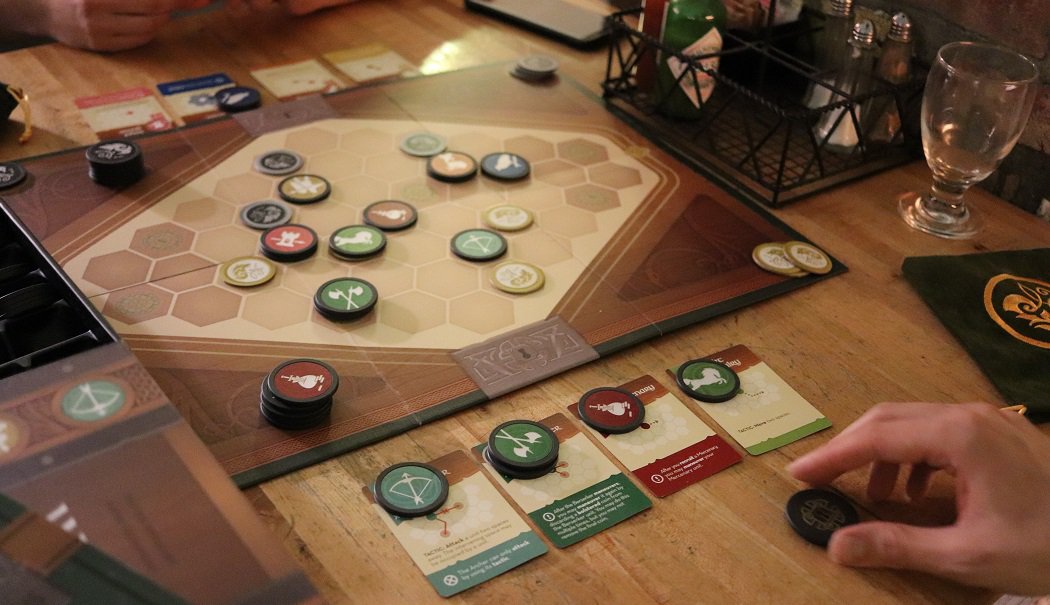
It’s a little, thematic, abstract game called War Chest.
Rules Of Engagement
Yes, you heard me right. It’s a thematic, abstract game. I say that because when I teach War Chest to new players, I describe basic strategy in one of two ways based on the personality of the other player. On one hand, you can approach this skirmish wargame purely from a mechanical standpoint, calculating hexes of movement and weighing special abilities. On the other hand, you can describe actions as the sweeping gestures of a military general: “it would be good for my cavalry to go wide and flank those archers. If I do that, you can park spearmen in front of advancing cavalry to stop the charge. You absolutely should shield your squishy range units with tankier front liners." It all makes sense if you’ve ever played a tabletop wargame, and yet if you don’t care one bit about theme, you can still scratch that itch for a thinky, tactical game in about thirty minutes or less.
How do you play War Chest anyway? You can explain it in five minutes or less with some practice! In each game round, players drawing three hefty, weighted poker chips out of a bag. They spend these chips back and forth to purchase new chips for their bag, claim initiative for the next round, and to deploy onto the board or activate a matching unit (moving, attacking, or using that unit’s special power). There's only a total of 9 different actions you can take, and with there only being three actions per 'round', it makes each decision feel weighty and decisive. The coins you spend end up in a discard pile that your opponent can see, some face down and others face up, which can give your opponent valuable information that we'll get to later.
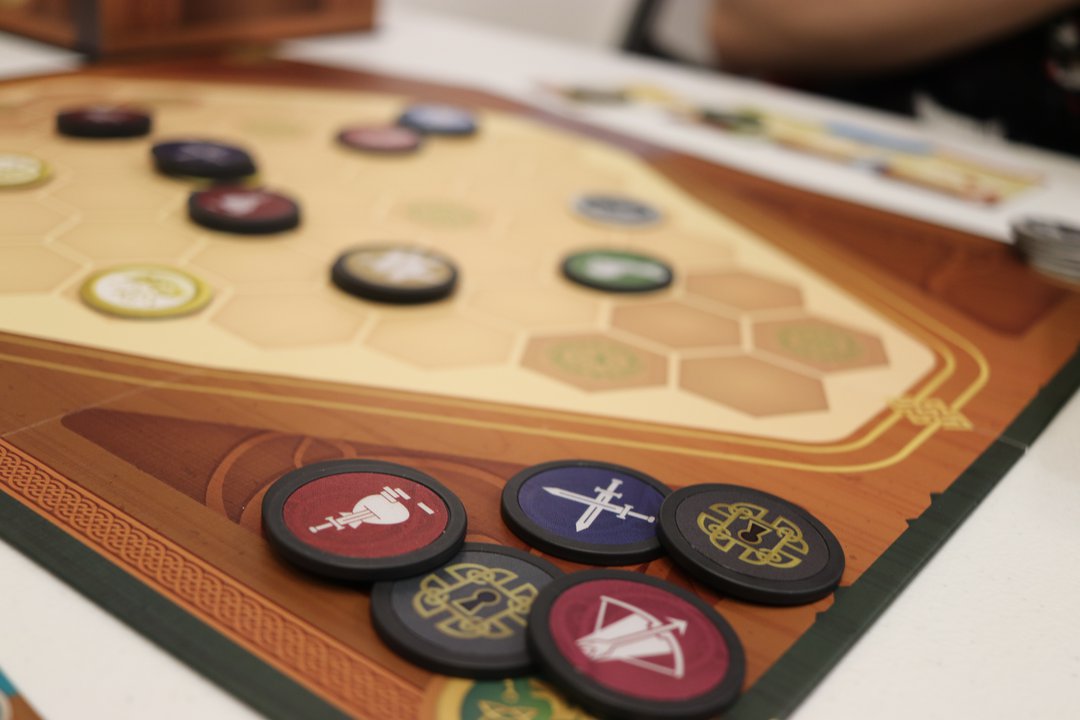
Keeping track of all information, not just what your own units do, is a very important part of War Chest.
The objective is to claim six control points - which also act as camps you create new units at - printed on the map before the other player. Broadly speaking, you battle over contested area, claim objectives, and race to claim victory rather than getting mired in endless skirmishes. The field is small which forces conflict, but units removed due to battle are put back in the box, so the fighting has a limited lifespan. It’s the very definition of simple to teach, hard to master.
Form Follows Function
War Chest might just be the most distilled skirmish wargame I’ve ever seen. Each choice you make matters, and each action alters the flow of resources and power. At the start of the game, player gets four different units either dealt randomly off a deck of reference cards or drafted once you’re familiar with the game. You take the weighted poker chips that match these units and stack them on the cards, and then you drop two of each into your bag to seed it for setup. The rest are put to the side in stacks called your Reserves, which can be purchased later. This is incredibly important because the chips you use for your actions are also your playing pieces. When you play a coin to the field, that means you have one less chance to draw a matching symbol to use that figure.
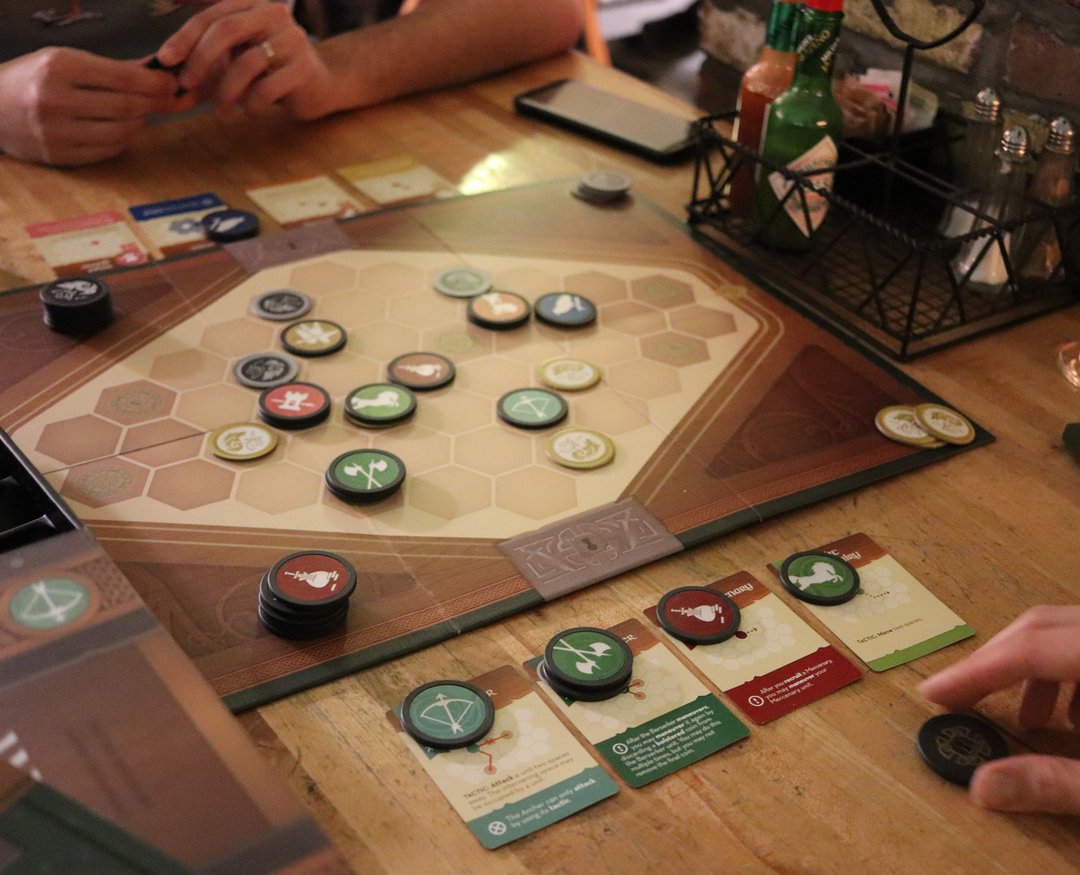
This part is what Wyatt raves about when we play, about how you are actively manipulating the odds of what armies on the field can do and what actions are available to you at the same time. Play passes back and forth as players deploy units and purchase more chips for their bags, effectively increasing the likelihood that those units can be activated or survive attacks, but you can't do both at the same time. Purchased chips go into your discard pile until the bag is empty though, ensuring some time before “reinforcements” arrive. Remember what I said about your discard pile giving away valuable information? A good opponent can see that you used one swordsman to play one on the field, and that you've used another to move it. They know that until you refill the bag, you can't activate that unit again.
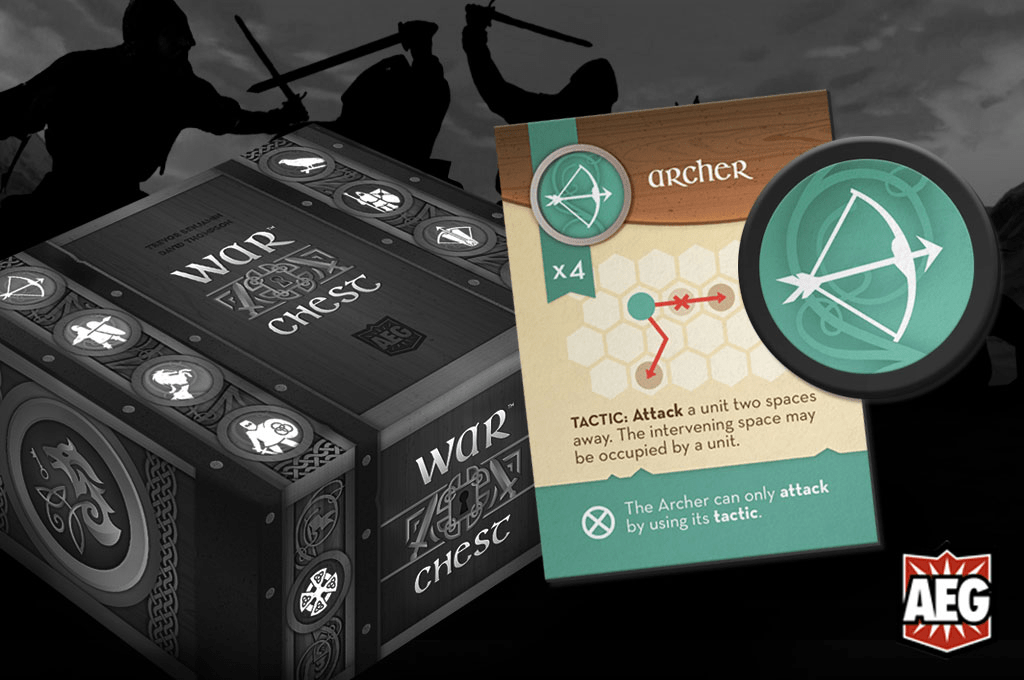
The units you get will force you to change your strategy. Archers are great, but can be vulnerable to fast units.
Of course, this is where a really good player starts realizing that they can fake out their opponents. Using the scenario above, you can play a swordsman coin face down to buy another swordsman coin, or to do something else like steal the initiative. Your opponent might not be willing to act until they know you've used up all your swordsman coins, and they don't know you've used the second one, throwing their plans into uncertainty. This is where the Royal Coin, a coin you can usually only use face down, actually can be really valuable. Using face down actions like purchasing, or even just passing, is a way to try and out maneuver your adversary. When is the last time you've played a game where passing an action in the middle of the game is a viable strategy?
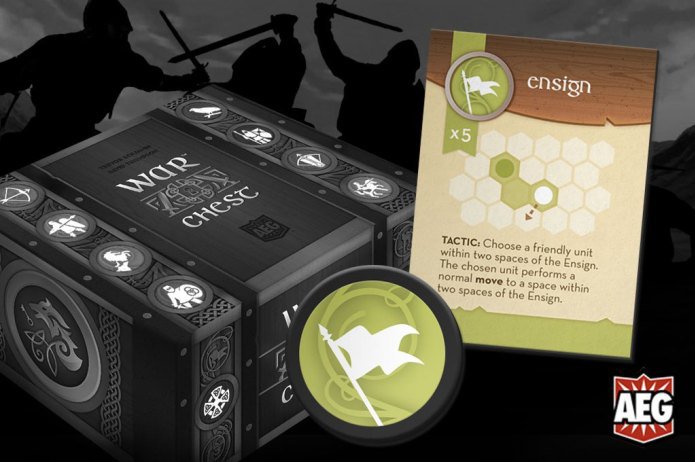
There are more complicated units too - The ensign allows for a crazy amount of movement manipulation. Each combination of units will create a brand new set of challenges.
As the board develops, all the greatest elements of your favorite wargames come out to play. Battlelines are drawn that no one wants to commit forces across, though the objective points you need to win are beckoning. A ranged unit on the other side gets close enough to start firing arrows, forcing you to deal with them. Quicker forces spring light ambushes from seemingly nowhere. You hold a particular unit back as your bag reshuffle approaches, hoping to increase your odds to draw at least two of its chips in a single hand, allowing you to surge forward and take out a troublesome ranged enemy. All the while, only up to eight total units are on the board, and turns are as fast as snapping one of the satisfyingly weighted chips onto the table.
The Art Of War
This game is just lovely on every count. From component quality to the way it reveals itself in play. The chips are hefty and sit well in the hands. It’s no exaggeration to say how enjoyable it is while waiting for my next move to just toss them around between my fingers (without revealing what I’m holding, of course). The board is clean and functional. The cloth bags are thick, easy to get a hand in and out of, and have some lovely embroidery. The box itself feels special, having been made to allow space for more coins in future expansions to be added, the magnetic lid revealing your 'armies' with a satisfying click. The reference cards have both text and pictures clearly indicating what units are capable of. As a best practice, when I play War Chest, I like to announce what a unit does the first time I deploy it so as to let my opponent know what they’re facing without overloading them up front.
Relatedly, the character of each game you play will change greatly depending on which four units you command. I once lost a game in record time because my opponent had two very fast units, some cavalry and the Scout who can deploy outside the normal zones, and they rushed the objective points before my slower, armored units could advance. They recognized their strengths and capitalized on them! I won another game because I made a feint to one side of the board, then ran up the other using the extra movement that the Mercenary coin gives you, flipping my opponents backmost control points when they shifted their guard. War Chest allows you to be clever. It lets you feel like a master tactician when you pull off a brilliant set of maneuvers, and similarly when you lose it feels less like the product of random bag draws and more because you didn’t plan accordingly.
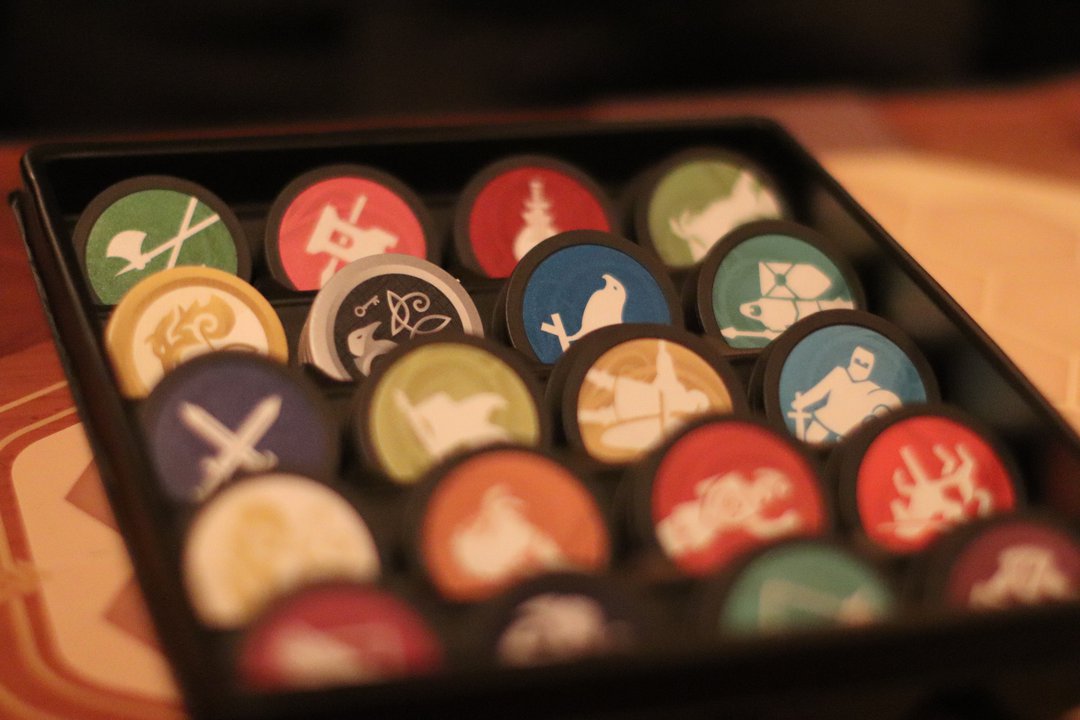
It doesn't hurt that War Chest has gorgeous components, giving you a lot of game in a small box.
I do have some nitpicks of the game, of course. For one, it can be a little difficult to see the control markers underneath the unit chips, and it’s especially frustrating when you lose because you thought your opponent had four points under their control rather than five. This is fixed easily enough by offsetting units on objectives rather than squaring everything in a neat stack. The Royal Coin also presents some issues. Under normal circumstances, since you cannot use it to activate units as mentioned before, you can only use it to buy new chips or grab initiative. However, one unit, the Royal Guard, can spend this chip to move. This gives the player who drafts the Royal Guard a slight advantage. It’s such an interesting design choice to allow this normally less-than-great chip to do special things with special units, but it’s a shame they only put one unit in the game that utilizes that coin. In future expansions I really hope we see more units that redefine the use of the royal coin in interesting, fun new ways.
The random pulls from your bag might seem reproachable at first, but in practice they almost never lose you the game on their own. If you know you haven’t pulled a particular unit in a while, you can be sure those chips are coming before your reshuffle and can plan new tactics accordingly. Ultimately, like any good wargame, War Chest reminds us sometimes you have to cut your losses or adjust to the situation you’re handed. It’s ok to lose the battle if you win the war! In fact, War Chest probably does this better than most skirmish games: while there's randomization in your coin draw, there's no dice anywhere, no randomization if you hit or miss. You start a round knowing some of your own odds, and its up to you to determine the risk of committing to your plans. Do you think your opponent can counter this turn, or the next?
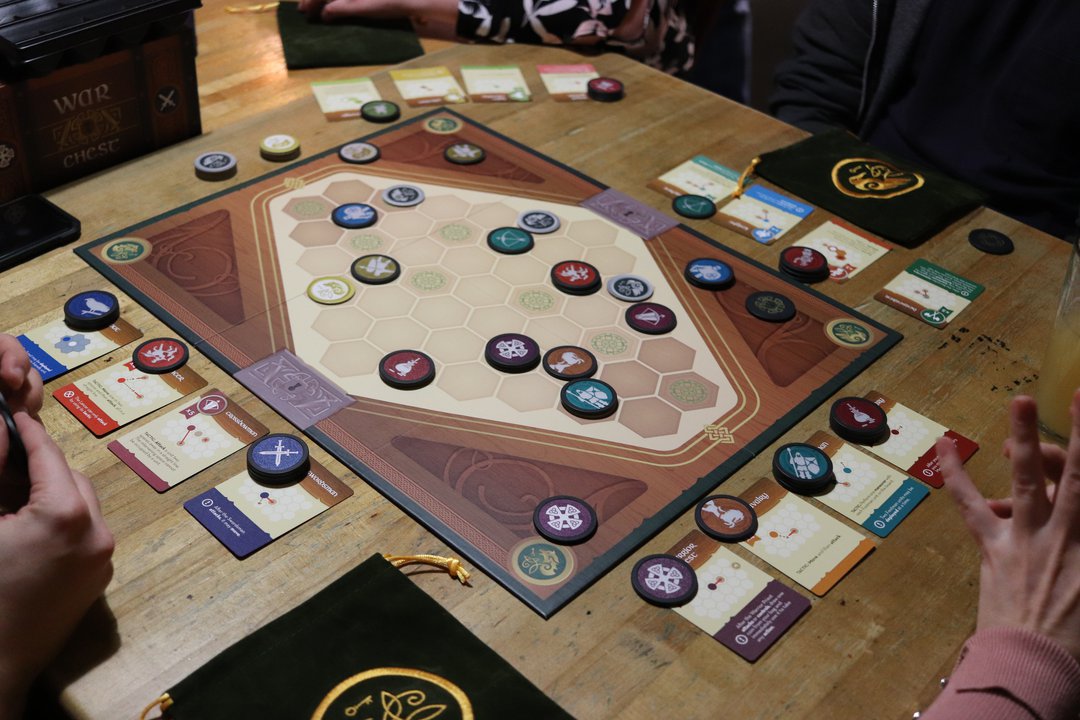
Four player games are possible, but get a bit hectic with the board becoming so crowded.
So who isn’t this game for? Honestly, I think only people who firmly don’t enjoy head-to-head abstract games. Granted, there is a 4 player mode where you play in teams of two; yes, each player still controls four units of their own, so the team game can get pretty heated. It’s fun to divide the board while asking for backup and holding one front for your buddy, but predominantly this game shines as a two player experience. If you’re not comfortable with the back-and-forth nature of this Chess-like game, while I think weighted poker chips still have massive appeal as a game component, you’re probably not going to find anything particularly novel that draws you in. If you don’t play a lot of games at the two player count, there’s also that to consider.
Who Dares, Wins
Overall, any complaints I have of War Chest are minor. This game is easy to teach, clean in its execution, and quick in its gameplay. Over the last year Wyatt and I have shown it to veteran gamers, curious newcomers at game night, my family who enjoys Chess, and lovers of both thematic wargames and mind crunching abstracts alike. They’ve all loved it. It doesn’t overstay its welcome, and it tends to leave people itching in that “just one more game” mood. “Do you want a rematch,” I hear more often than not, and because it plays so quickly you’re easily able to oblige.
Go ahead, play just one game in a sitting. I dare you. I’m not honestly sure if it’s even possible. It’s not often I review a game that sits this well with both me and anyone I’ve played with, and that makes War Chest, in my opinion, one of the greats. It's the world's most compact war game, giving enough theme and atmosphere to feel like the leader of an army while not having to spend hundreds of dollars on miniatures. At a price point of only about $50 MSRP, you get a lot of value in the replayability and production quality. If you get a chance to check it out, I recommend you do. At least for me, this game is withstanding the test of time just fine, and I look forward to all the games I’ll continue to play over the years it remains on my game shelves.